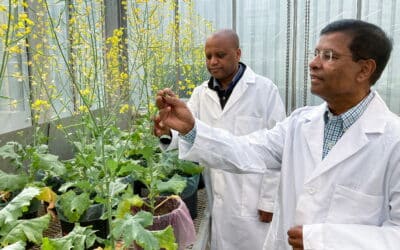The first hybrid brown mustard and a whopping 61 other cultivars were put forward for registration at this year’s meeting of the Prairie Grain Development Committee.
In some ways, this year’s meeting of the Prairie Grain Development Committee (PGDC) belonged to the mustard plant.
Held at the end of February 2018 in Banff, Alta., the PGDC’s Prairie Recommending Committee for Oilseeds (PRCO) put forward only one line for registration, but it’s a major one — the first hybrid brown mustard ever released.
B3318 has significantly higher (24 per cent) yield than the check variety, Centennial Brown. Developed in the breeding program of Bifang Cheng, the condiment mustard breeder with Agriculture and Agri-Food Canada in Saskatoon, it’s aimed at the European market, where brown mustard is used to produce Dijon mustard.
But according to Kevin Hursh, executive director for the Saskatchewan Mustard Development Commission, it opens up a wealth of possibilities for the Canadian mustard industry.
“A 20 per cent yield boost over the check variety is hugely significant for growers. The question will be if can we produce hybrids that present a good value proposition for growers,” he says. “Preliminary information seems to indicate that yes, we should be able to do that. Companies specialize in hybrid production both in Alberta and B.C., and with winter nurseries in Chile, the industry should be able to help this take off.”
PGDC acts as a forum for the exchange of information relevant to the development of improved cultivars of grain crops for the western Canadian Prairies and advises regulatory agencies about legislation and regulations governing grain breeding, cultivar production and sector development.
This year, a whopping 62 cultivars in four different crop categories were recommended for registration, delivering even more options for stakeholders throughout the agriculture sector and beyond.
Among those cultivars were 23 pulse lines put forward by the Pulses and Special Crops Committee (PRCPSC). As demand for pulses goes up, breeding for new pulses to satisfy consumers is booming along with it, notes Peter Frohlich, pulses and special crops project manager for the Canadian International Grains Institute (Cigi).
He addressed the PRCPSC this year to unveil some recent work done by Cigi in the area of pulse flour. Under the Advancing Pulse Flour Processing and Applications project, Cigi is continuing the development and optimization of pulse flours as high-quality food ingredients to further their commercial use in pulse-based products.
“One of the biggest obstacles for the pulse market is flavour. Pulses are extremely nutritious, however consumers often don’t like the flavour of them when used in certain products,” Frolich says.
According to Frohlich, as demand for ingredients like pulse flour goes up, processors will be looking for ingredients that add good flavour — or none at all — to their products. That’s where breeders involved with PGDC come in, Frohlich adds. “Addressing flavour issues around pulse ingredients starts at the breeding level.”
As processors look for ingredients with qualities like improved flavour profiles, breeders continue to deal with new challenges and opportunities presented by new technology. The theme for this year’s PGDC plenary session was disruptive change and transformational technology. Speakers included Tim Sharbel, professor in the plant sciences department at the University of Saskatchewan, and Erin Armstrong, industry and regulatory affairs director for Canterra Seeds.
Sharbel spoke about launching an apomixis research program at the Global Institute for Food Security, located at the University of Saskatchewan. Apomixis is a naturally occurring phenomenon in certain types of plants like St. John’s wort and Kentucky bluegrass, which reproduce seed asexually, whereby all offspring are genetically identical to the mother plant.
It isn’t found in any food crops, but if apomixis could be successfully introduced into agriculture, Sharbel says it could be a disruptive technology. Essentially, it would enable the immediate fixation of any desired genotype and lead to faster, simpler breeding schemes.
“People have been studying the biology of these asexual plants and animals for 100 years or so, but it’s only 20 or 30 years ago that people started thinking about it in terms of agriculture,” he says. “There are a number of laboratories around the world studying apomixis. It’s worth billions of dollars if we can get it working.”
Armstrong’s presentation focused on two value creation models for cereals she has been working on with Tom Steve, general manager of the Alberta Wheat Commission. Together they co-chair the Value Creation Working Group (VCWG), a sub-committee within the federal government’s Grains Roundtable (GRT). It was formed in 2016 to inform the federal government as to the potential for a new royalty system for cereals. (See page X to read more about value creation in cereals)
“The idea that value creation and capture could be a part of Canadian agriculture in the future is something that could really change how things work. We could see an influx of new investment in breeding and new opportunities for other companies and organizations to be involved,” says Mitchell Japp, PGDC chairperson.
“It’s at the idea stage right now and we don’t know how it will play out, but it will ultimately affect both the breeding side and the seed development side.”
BY THE NUMBERS
The breakdown of cultivars recommended for registration at this year’s PGDC meeting is:
PRCWRT:
- 14 Canada Western Red Spring
- 1 Canada Northern Hard Red
- 1 Canada Western General Purpose
- 1 in Canada Western Special Purpose
- 2 Canada Western Special Purpose winter wheat
- 3 Canada Western Durum Wheat
- 2 spring triticale
- 1 winter triticale
- 1 fall rye
PRCOB:
- 3 oat
- 7 barley
PRCO: 1 mustard
PRCPSC:
- 5 dry bean
- 6 lentil
- 8 faba bean
- 4 field pea
- 1 buckwheat





